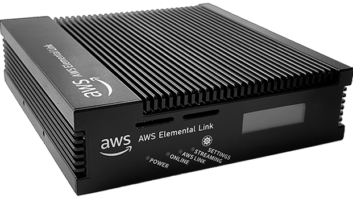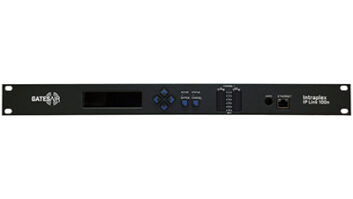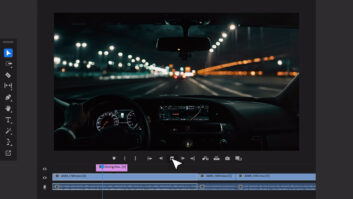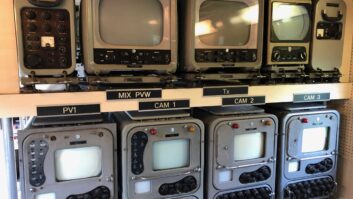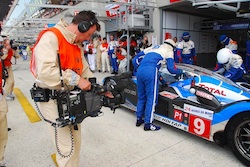
As David Fox reports, there are a growing number of choices if you don’t want, or can’t have, wires.
Any obstructions in the RF signal path can cause you to lose wireless pictures at an event. To counteract this, Vislink News and Entertainment has added Deep Interleaving, which it claims “can compensate for transmission disruptions of up to four seconds in duration, and includes instantaneous relocking once the signal is restored.”
Deep Interleaving is particularly useful when covering fast paced events, such as motor sports and bicycle races, where bridges, trees and other obstructions frequently block the transmitter to receiver signal path.
It is currently available as an option for Link’s XPu vehicle on-board systems and the new XPc mini transmitter, and will be available for the L1500 and L1600 transmitters, and as a software upgrade for current users (it doesn’t require any additional hardware).
It was first used for the 2009 London Marathon, where SIS Live obtained uninterrupted coverage using a motorcycle mounted camera, and has also been used at the Los Angeles Marathon and for live on-board coverage at the Le Mans 24h race. “Deep Interleaving gave superb pictures at Le Mans, with no breaks, throughout the whole race,” said Yves Le Moing of Comat, Paris, which supplied the Cellular Diversity network and seven Link XPu transmitters on-board competing cars, plus Link L1500 systems on the pit lane cameras.
LMS-T serves an ace
LMS-T modulation can carry high bandwidth data more reliably than DVB-T, according to Vislink. For the 2009 US Open Tennis championship at Flushing Meadows, New York, CP Communications provided CBS Sports with two Link L1500 HD wireless camera systems — one of which was used in 20MHz Dual Pedestal mode with the L1500 optimised LMS-T modulation scheme.
“The Dual Pedestal operation was a request from CBS and we had not tried it before, so we upgraded the receivers to operate this. We were a little wary of the signal strength and coverage area at first, but once we got into it, the Link LMS-T proved that its transmission scheme was superior to other products we might have used.” said Kurt Heitman, SVP, CP Communications.
LMS-T exploits more channel bandwidth than DVB-T and boasts superior error correction. Unlike DVB-T, it does not suffer from excessive dropouts and interference at the bandwidths required for high quality HD transmission. CP Communications linked receive sites around the tournament venue using its own RF-over-fibre and employed Vislink’s new HD ASI switching to connect three daisy-chained Link receivers.
Vislink has also added IP interfaces to its SNG and wireless products, to allow broadcasters to send encoded live video or pre-recorded video over IP networks. Its DVE5100 Encoder and Modulator and its IRD5100 Integrated Receiver Decoder can now encapsulate pre-encoded ASI streams into IP for transmission from an OB to the studio and can decapsulate one of up to four pre-encapsulated ASI signals from an incoming IP stream.
Vislink’s MRC microwave products have also been IP enabled. The AMG2100 and ASG2100 smart mobile and studio gateways offer wireless broadband and microwave links between the ENG/ OB and studio, and can support a large fleet of vehicles simultaneously. When equipped with an MTX5000 transmitter, a vehicle can transmit live video and pre-recorded files via IP. The units include software for remote control and will be able to manage the transport of news to the studio in a workflow.
“Vislink’s new IP-enabled product set will enable broadcasters to route video in a single workflow from the camera and OB trucks, over any kind of RF, satellite or microwave link or IP network, and directly into the broadcaster’s own IT network,” explained Ashley Dove, Director, Product Marketing, Vislink News and Entertainment.
Ikegami unwired for HD
Ikegami’s new HD wireless system is integrated into its HDK-79EXIII (1080i native) and its HDK-727P (720p native) studio and EFP cameras. It boasts an overall delay of less than 60 milliseconds, at 64 QAM, with eight channels and a bit rate of 5Mbps to 27Mbps. It uses the 2.2 to 2.5GHz frequency, with up to 2.7GHz on request and there is a 7GHz band version in development.
“Because it’s integrated into the body, it’s really neat,” said Mark Capstick, general manager, Ikegami Electronics UK. Two-way and six-way diversity receivers will be available. The distance between transmitter and receiver depends on the type of antenna, but can be up to 500m. The system can also send camera control and tally signals, and users can use the standard OCP, giving the same operational control as with fibre studio/OB cameras.
If you want wires, there is also a new fibre optic adaptor for Ikegami’s solid-state GF CAM series. The FE-C10 Fibre Camera Adaptor allows HD-SDI and two-channel audio signals to be transmitted up to 2km. The FE-B10 Fibre Base Station can transmit return HD-SDI signals, intercom, genlock and Tally to the camera head, turning the GF CAM into studio/OB cameras.
Boxx clever
Boxx TV’s Meridian HD boasts zero latency (less than one millisecond), and can carry uncompressed HD signals up to 1080/30p and 1080/60i at 4:2:2. Because there is no encoding, there is no delay. It also uses MIMO (Multiple Input/Multiple Output), which “allows it to carry a huge amount of data,” explained its CTO, Scott Walker.
It transmits over the licence exempt 5.1-5.9GHz spectrum, which allows it to carry 20MHz worth of data, although only over short distances. “It is really comfortable at 100m and maxes out about 250m, so it would be suitable for a football stadium.” Users can daisy chain receivers to extend its range, switching the SDI signal to whichever has the best signal strength.
It has been designed to protect the most important parts of the picture, so that as it degrades it loses the less noticeable pixels first (such as those in shadows). “It degrades like gain in cameras,” he said. The 9W transmitters have HD-SDI, SDI, component, and composite video input and two channels of embedded or balanced analogue audio, and use 256-bit encryption. The receivers have a six-antenna array.
Its first users include a basketball stadium, a church in Texas, and a couple of Hollywood movies. A full broadcast system, including telemetry, costs about £22,000. There is also a video assist system, which shipped first (and has sold many more). It costs £6,000 and has a shorter range (about 60m) and only carries SD or 1080i HD.
Also new is Azure, a lightweight camera-mountable 3G system for transmission via mobile phone networks. It can handle full frame, high-quality, live camera feeds, and can use up to four carriers at once, to achieve speeds of up to 4Mbps.
TitanHD is MIMO too
Transvideo’s new TitanHD also uses MIMO and COFDM to carry 10-bits uncompressed HD video, plus two audio channels (embedded or analogue), with ‘zero latency’ (less than five milliseconds). Its range is no more than 90 metres outside, 40 metres inside. The system accepts all HD/SD SDI formats except 1080p/50 or 60, as well as PAL and NTSC.
It is apparently particularly well suited to Digital Cinematography, and can carriy full Cooke i/ lens data (Eur600 option) as well as timecode, Tally light and simple GPI remote signals. It supports data rates up to 1.5 GBps, using the 5GHz ISM band. It costs about Eur8,700, but an upcoming, light version (thinner transmitter, no SD or audio) aimed at monitor use should cost less than Eur5,000. It is also developing a 4:4:4 version.
Nano technology
Broadcast Microwave Services Europe’s new Nano transmitter is smaller than a packet of cigarettes, and boasts low system latency. Its small size is due to its use of a single chip design, using low power Field Programmable Gate Arrays. These “allow us the flexibility to tailor certain parameters to customers needs. Software based encoders can be reprogrammed to be a decoder; compression algorithms can be switched; monitoring is made easier; custom change requests can be implemented by software. MPEG-2 algorithms are currently the preferred compression method, but expect video production to switch to H.264 over the next few years. The change to H.264 will be supported through firmware upgrades to BMS products,” explained Rainer Horn, managing director, BMS Europe.
For worldwide use, its products can be used at frequencies between 400MHz and 7.5GHz, providing alternatives to the congested 2GHz band.
Hawk-Woods has introduced a wireless video monitoring system. The 5.8GHz diversity system that “gives rock-solid pictures both indoors and out. Outside it is capable of more than 100m direct line of sight. It has seven channels and can run three cameras to the receiver (using every second channel to avoid cross over),” said Hawk-Woods’ Director Brian Woodford. The package of transmitter, receiver (with 7-inch LCD monitor) will cost about £800, which he claims is “a good 50% cheaper than the competition.”
ChannelMaster upgrades
Nucomm has updated its ChannelMaster7 series of portable microwave links with a several new features including: DVB-S modulation (in addition to the FM analogue and DVB-T/VSB digital options already available); new tripods and mounting hardware: and a new user interface. It already offered SD/HD transmission capability and multi-band operation.
Customers had wanted support for higher data rates than those available with standard 8MHz DVB-T (which is up to 31.7Mb/s), so Nucomm added DVB-S, which more than doubles the data rates of DVB-T.
Nucomm’s sister company, RF Central now offers the RFX-RMR-X6-II-D six-way COFDM diversity receiver with an internal SD/HD Decoder. Using maximum ratio combining, it boasts improved diversity reception. Other new features include: On screen display of stream data; Ethernet monitoring for remote control access; and IP encapsulation for Internet broadcast. The unit comes as a stand alone COFDM receiver with ASI output or with an integral SD/HD decoder for local decoding and control.
